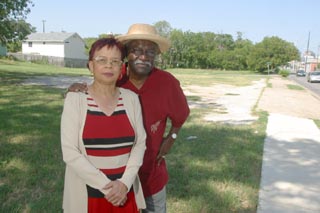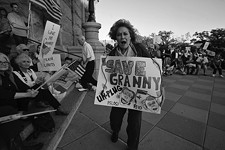The ARA Faces the Music
For the Austin Revitalization Authority, Eastside Renewal Proves to Be a Long, Slow Dance
By Amy Smith, Fri., Aug. 29, 2003

Back when she was a liberal Democrat and the mayor of Austin, Carole Keeton McClellan (now the conservative GOP state comptroller, Carole Keeton Strayhorn) spent a good bit of her time cutting ribbons at grand openings. One such occasion took her to 1104 E. 12th on a glorious spring afternoon in 1981, where a crowd cheered as she snipped a yellow ribbon strung neatly across the entry to Minnie's Beauty Salon.
It may have been just a glad-handing opportunity for the ambitious mayor, but the symbolic gesture meant the world to the shop's owners, Leonard and Minnie Mann, and to anyone with a vested interest -- be it wallet or spirit -- in East Austin. McClellan declared Minnie's a catalyst for what was certain to be an imminent economic revival along East 12th, a street that had fairly hummed with successful African-American-owned businesses before the neighborhood hit the skids in the Sixties and was then decimated by urban renewal in the Seventies.
By the time the ribbon was cut, Minnie's had already been operating at a steady clip for 10 months, offering convincing evidence that the neighborhood was primed for a commercial takeoff while the rest of Texas was soaking in the riches of its last oil boom. "It was a grand affair," Leonard Mann said the other day, smiling as broadly as he is in the photos taken on that Sunday afternoon. "We were really blessed," Minnie Mann echoes, thumbing through a photo album that chronicles the history of a business that, more than two decades later, is now on its third generation of clients.
Just getting the initial financing for Minnie's -- built from the ground up -- was in itself an amazing feat. "I went to five different banks trying to get a loan," says Leonard, 71, who grew up a couple of blocks south of the shop on Juniper Street, which is now slated for a major makeover with both new housing and renovated historical homes. Though the Manns now live in Pflugerville, they say their heart remains in East Austin.
"This is our neighborhood," says Minnie, a youthful 66-year-old who -- as most of her friends and Eastside neighbors are well aware -- is the more outspoken of the Manns. "We wanted to come back to help improve the area, but the banks couldn't understand why we wanted to invest in East Austin. Leonard had a job at IBM, we had good credit, we had collateral -- and they didn't want to give us a loan. We didn't know then that they were redlining."
Minnie's still stands out as a rare thriving neighborhood business on East 12th, which still looks much as it did two decades ago when McClellan pronounced its brand new day. From I-35 east, one finds aging landmarks like the King-Tears Mortuary and the former Masonic temple, family-unfriendly bars near Chicon, start-up storefront churches (and the Nation of Islam), and a lot of vacant property. Across 12th from Minnie's is a large, long-empty tract that's slated for a housing project the Manns strenuously oppose; a block away, the former Communications Workers of America union hall has been sitting, vacant and deteriorating, for well over a decade. Looking west, you can see construction cranes hovering over Downtown; but for East 12th, not one but two booms have now passed by.
On this warm Monday morning, the Manns sit at a small table in the kitchen at the back of the shop, recalling their original dream of expanding the store into a beautician school and an upscale salon and fitness center. They talk with the easy familiarity of a couple who've been together for 47 years, finishing each other's sentences and filling in the gaps when the other's memory clouds. A ceiling fan whirs overhead. They don't fault McClellan for East 12th never taking off the way she said it would. She wasn't the first, and certainly not the last, public official to make such promises.
"They're Holding Us Hostage"
Mostly, the Manns lay blame for the lack of progress on East 12th on the bureaucracies overseeing the street's renewal -- the city's Neighborhood Housing and Community Development Dept. and the nonprofit Austin Revitalization Authority, which has received millions of dollars in public funds as the city's contracted agent for implementing the East 11th and 12th Street Community Redevelopment Plan.
The brainchild of former Council Member Eric Mitchell, the ARA was created in 1996 to use local, federal, and private funds to bring new life and investment to the corridors and, by extension, to all of Central East Austin. After years of conflict between the Mitchell-era ARA and surrounding neighbors and other Eastside stakeholders -- who were initially and pointedly excluded from its board and decisions -- the agency currently operates with a board of 29 members representing a diverse array of neighborhood, community, and business interests. The Community Redevelopment Plan -- an urban renewal plan with the force of law, with which property owners on 11th and 12th are required to (eventually) comply -- was adopted in 1999 and prescribes in some detail a future vision of 11th Street as a commercial and entertainment district and 12th as a mixed-use urban corridor.
Leonard Mann, in fact, was one of the ARA's original board members, representing 12th Street property owners. But he quit the organization a few years later over disagreements with the CRP's mixed-use, less intensely commercial vision of 12th Street. In particular, the Manns oppose the plan's call for 16 town homes across the street from Minnie's, which are slated to be built by the city NHCD Dept. The Manns and others have since formed the East 12th Street Property and Business Owners Association to collectively oppose that project, which they believe would limit their development options by imposing height restrictions and other restraints on the adjoining commercial parcels. They feel this would deprive them of the opportunity to turn a just profit on the sweat they've invested on 12th Street for decades.

The 12th Street group includes some of Austin's most prominent African-American citizens -- Willie Mae Kirk, Scottie Ivory, Thomas Henderson, the Wormleys -- but the primary players are Leonard Mann, who serves as president, and Richard Ferris, a lifelong Austinite of Lebanese descent who has taken his land-use battle one step further with a lawsuit against the city. Ferris owns what is now a small multifamily complex less than a block east of I-35, which he thinks is a perfectly sensible location for a commercial project -- but he argues that the ARA plan and the proposed homes nearby mean he can't get backing for such a development.
As it turns out, the town homes slated for 12th Street ended up in the ARA plan as a compromise solution to another rancorous matter. The homes are part of the Anderson Hill affordable-housing project, formerly known as SCIP II (Scattered Cooperative Infill Program), another pet project of Eric Mitchell's, initially developed by the Anderson Community Development Corporation and its consultant, former city housing director Gene Watkins. The town homes were conceived as a buffer between the single-family Anderson Hill homes between 11th and 12th, and the commercial corridor the ARA was charged with creating. In 2000, the city basically kicked Anderson CDC and Watkins out of the project, took over the property, and is now committed to building out Anderson Hill -- including the town homes -- itself.
Ferris' lawsuit is one reason why neither the town homes nor much else has moved forward on 12th Street. Another complication is a formal complaint Mann's group filed last year against the city with the U.S. Dept. of Housing and Urban Development, questioning why most of the ARA's allocated federal urban-renewal funds have gone toward renovating 11th Street, leaving 12th still in a state of disrepair and private landowners in limbo. "This is ridiculous," says Ferris. "They're holding us hostage on 12th Street."
Redrawing the Blueprint
But throughout the city, not just on the Eastside, the options for commercial development -- the nature and size of what goes on the ground -- are limited by the neighbors who have to live next to it. In other words: coffee shop, yes; big honking office complex, no. The surrounding collection of ethnically diverse Eastside neighborhoods -- each with its own set of personalities and politics -- worked together to develop the city-sponsored neighborhood plan for Central East Austin, which the council adopted in 2001. (Chronicle City Editor Mike Clark-Madison was chair of the Central East Austin neighborhood planning team and now chairs the neighbors' coalition group, the Organization of Central East Austin Neighborhoods, or OCEAN.) That neighborhood plan, which built on work done earlier by the ARA itself, calls for mixed use and neighborhood-serving businesses that are compatible with the surrounding residential areas, but it is silent on East 11th and 12th streets proper, because the ARA's urban renewal plan takes legal precedence. But neighborhood leaders, most with representatives on the ARA board, are vigilant about monitoring implementation of the ARA plan as it bumps along at a tortoiselike pace.
Right now, the ARA is modifying the CRP itself -- some necessary tweaking here and there, with the option of further changes to make the urban renewal plan better reflect the neighbors' and property owners' goals and the market realities. This process hit an unexpected snag last month when the ARA sought City Council approval on various minor amendments, which had been endorsed by both the ARA board and OCEAN, easing the chances for a 7-0 council vote. But things went a little awry when the 12th Street property owners showed up, either in the flesh or in writing, and registered opposition. The council eventually approved only certain changes affecting 11th Street; the ARA and 12th Street stakeholders and neighbors have gone back to the negotiating table for another round of community meetings to secure consensus for a revised plan. Then it's back to the council in March.
The 12th Street owners, meanwhile, are developing their own blueprint for their corridor -- what they call the East Austin Urban Renaissance Vision -- and they intend to pursue a settlement on the town homes that would put the planned residences on top of ground-floor retail or office spaces. Paul Hilgers, director of NHCD, will neither commit to that proposal nor discount it altogether. It could work, he said, "if that is what is decided by the public process being led by ARA and is approved by the City Council as a plan amendment."
Eric Shropshire, a financial consultant assisting the 12th Street owners in their planning, laid out the group's goals at a community workshop held by the ARA two weeks ago at Zion Hill Baptist Church in the Chestnut neighborhood. "We want to recapture the customer base [the street] once had as well as integrate with the downtown business market," he said. Meanwhile, architect Donna Carter, who is on contract with the ARA, gave a presentation to show how other areas of town have rendered successful mixed commercial and residential neighborhoods -- from West Sixth, to Duval in Hyde Park, to Tarrytown and South Congress.
The meeting was remarkably civil. "We really made some progress," said Steven Aleman, the Chestnut neighborhood representative on the ARA board. "To the extent that we can now talk instead of shout, I think that's good."
Marshall's Balancing Act
Evidence of ARA's progress is, of course, more visible on East 11th, where not long ago the signs of blight were everywhere. Balcones Recycling has taken up residence in the renovated Shorty's Bar; a graphic design group, ShoeHorn Design Inc., bought and transformed the old Arnold Bakery into its new offices, and the historic Victory Grill continues to serve the community. ShoeHorn Design co-owner David West has lived in the neighborhood since 1983 and has watched the slow transformation from impoverishment to improvement. "When I first moved here," he says, "I couldn't even walk my dog. Eleventh Street was pretty darn rough."
Heading east from I-35, folks are greeted first by the familiar Ben's Long Branch Barbecue (which, in accord with one of the just-passed ARA plan amendments, will be renovated and expanded instead of torn down and replaced), followed by a grand, inviting archway flanked on one side by a brightly colored mural. Construction on the ARA's first big new construction (as opposed to renovation) project, a mixed-use office/retail development called Eleven East, finally got under way this year on 11th between Waller and Curve, after a series of fits and starts. Finding tenants to fill that space is another matter, however; so far, only the NHCD itself has a signed lease. At 11th and Navasota (currently home to a Quickie Pickie), lawyer/developer and city Planning Commissioner Michael Casias, who lives nearby, plans a mixed-used project that, as part of the amended ARA plan, will add residential units to the mix.
Around the corner on Navasota are the ARA's own headquarters, home to President/CEO Byron Marshall, a former deputy city manager well versed in the bureaucratic nuances of City Hall. (Marshall also lives nearby, in one of the Anderson Hill homes.) Marshall has the challenging task of trying to shepherd the ARA's effort while fending off criticism and mending disputes on all sides. He takes issue with the frequent complaint that the ARA has accomplished little in its seven years of life and four years since the urban renewal plan was adopted. How does he respond to that criticism?
"I would ask them a couple of questions," he says between bites of a salad at Gene's New Orleans Style Poboys and Deli, another new business that's livening up 11th Street. "Before there was a plan, what was being done? And what prevented it from being done? The first four or five years we spent cleaning up the area, picking up trash, making sidewalk and lighting improvements ... if they read the plan they'll see that we're actually ahead of schedule." Mediating disputes between neighbors and landholders is one of the more time-consuming aspects of his job. "Part of the process is determining where it's appropriate to build tall buildings," Marshall says. "We're trying to balance the legitimate needs of the retail owners against those of the homeowners. Where 12th Street is concerned, we will look at each block anew."

And then there's the age-old gentrification debate. It can be both good and bad, he says. "Clearly the positive aspects of gentrification are redeveloping the neighborhood, and making improvements. [But] when you do that, you raise the property value. Gentrification is not a racial issue; it's a class issue. Where gentrification fails is when it causes people to be displaced."
The G-word looms large in community discussion of almost every project in Central East Austin, including the ARA's own planned housing development on Juniper, where future "market-rate" homes may be listed for as much as $250,000. But some stakeholders argue that gentrification is more of a future concern than an actual present-day crisis. "I know that there have been screams of gentrification," says ShoeHorn's David West, "but I think there's been much less of that than what people claim."
Mark Rogers, an ARA board member and director of the Guadalupe Neighborhood Development Corp., a nonprofit affordable housing group whose many Eastside units have helped deter gentrification pressures in the area, regards Marshall as one of the ARA's most valuable assets. "He's really our strongest suit because he knows how to get things done," says Rogers. "We have accomplished some pretty major things, and we've taken some steps to get the ball rolling." Now, he says, it's time for the ARA to start moving on 12th Street.
The 12th Street conflicts, of course, could take as long to settle as it took ARA to begin turning dirt on 11th Street. "I am very optimistic about the development of both 11th and 12th streets," says Paul Hilgers. "It has taken longer than we wanted, but we have accomplished more than many people thought possible. The ARA has proven that it can be an effective facilitator ... between conflicting interests in the area."
Does Hilgers agree that the 12th Street owners have a legitimate complaint? They "have a legitimate interest in how 12th Street is developed," he says. But "The urban renewal plan [already] includes significant planning and input from the citizens of the area. It is appropriate that the ARA is now going back to the citizens of the area and revisiting any input they may have as they update the plans for 12th Street."
"We're in the Third Act"
Not too long from now -- on Sept. 30, 2005, to be exact -- the ARA's contract with the city of Austin will expire, and it will become an independent agency that can, and will probably have to, find new sources of revenue, projects, and missions. The question of whether it should strike out on its own, outside the parameters of the 11th and 12th Street corridor plans, is answered in different ways by different stakeholders.
"That's a really tough call," says Rogers. "Part of me says get the first phase of the plan done, and then move to 12th Street and get out, and let the private developers come in -- with community oversight. The best development comes from the ground up, rather than from the government." However, Rogers adds, the ARA could serve a useful purpose by helping neighborhoods develop planning strategies. The ARA wouldn't choose the neighborhoods, he said, "but wait to be asked."
But ARA board member Larry Jackson, the director of the East Side Story youth services program, would like to see the ARA continue to expand its boundaries of influence in the community, utilizing the specialized talents of some of the board members. He cites both Mark Rogers and their board colleague the Rev. Sterling Lands as among the ARA's strongest assets. "They've actually got enough savvy to see what needs to be done and how to get it done," he says. "They understand the process."
Would Marshall himself continue his work with the ARA? "I don't see this as my lifetime work," he says, "but I do see how [the ARA] could benefit a larger part of East Austin."
In the meantime, Leonard and Minnie Mann are wondering if they will ever be able to retire. They can't keep up the business -- nor their battle with the ARA -- forever, after all. Their choices are limited at this point: They could bail out now by selling the business and the adjoining tract, but with property values so low in the neighborhood, they wouldn't make much of a profit. Or they could stay the course in hopes of reaching a resolution with the ARA and the neighborhood.
"We had so many plans and dreams to try to bring back the glory of the old days," says Leonard, "but now we're getting too old. You could say we're in the third act."
"We were in the second act when we moved here," Minnie adds. "But we hung in here all these years because we had too much pride to give up. This was my life's dream." ![]()
Got something to say on the subject? Send a letter to the editor.










